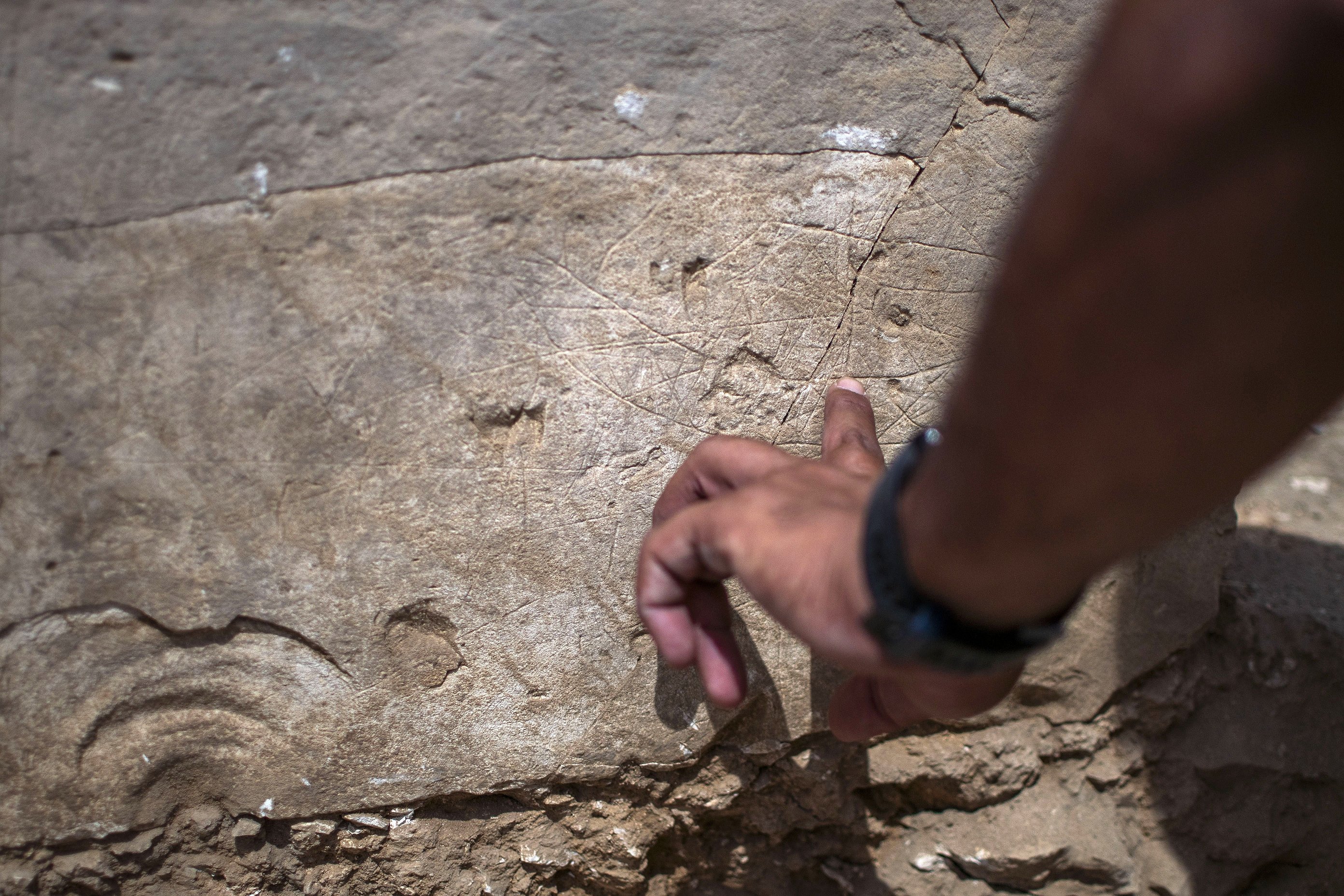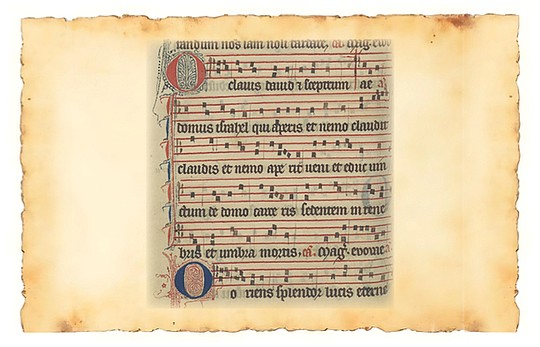Archaeological discovery in Israel dubbed 'greeting from Christian pilgrims' 1,500 years ago
June 15, 2024 at 8:45 p.m.

JERUSALEM OSV News – The discovery of a Byzantine-period church in the northern Negev, with wall art displaying ships, opens a window to the world of Christian pilgrims visiting the Holy Land 1,500 years ago, according to the Israel Antiquities Authority.
"The drawings provide first-hand evidence about the ships they traveled in and the maritime world of that time," said IAA Director Eli Escusido, describing the finds in southern Israel's large desert as "surprising and intriguing."
 An archaeologist points to wall art at the site of a Byzantine-period church in the northern Negev, an Israeli desert. According to archaeologists, it opens a window to the world of Christian pilgrims visiting the Holy Land 1,500 years ago. The Israel Antiquities Authority announced the discovery of the art May 23, 2024. (OSV News photo/courtesy Israel Antiquities Authority)
An archaeologist points to wall art at the site of a Byzantine-period church in the northern Negev, an Israeli desert. According to archaeologists, it opens a window to the world of Christian pilgrims visiting the Holy Land 1,500 years ago. The Israel Antiquities Authority announced the discovery of the art May 23, 2024. (OSV News photo/courtesy Israel Antiquities Authority)The IAA has been carrying out a rescue excavation for several years at the archaeological site located in the Bedouin city of Rahat in preparation for a neighborhood expansion project.
Excavation directors called the find "a greeting from Christian pilgrims" who arrived by ship to Gaza port, telling the story of settlement in the Northern Negev at the end of the Byzantine period (from approximately A.D. 395 – when the Roman Empire was split – to 1453) and in the beginning of the early Islamic period.
The archaeologists suggest Christian pilgrims visited the church after landing in the port, leaving their personal mark in the form of ship drawings on its walls. Though depictions of ships were used as a Christian symbol in ancient times, they said they believed that in this case the drawings of ships were a true graphical depiction of the real ships in which the pilgrims travel to the Holy Land.
They noted that the site of the ancient church with the ship drawings is adjacent to an ancient Roman road known as the Via Maris that led from the Mediterranean coastal port of Gaza to Beer Sheva, the Negev's main city and northward up to coastal cities such as Acre, Caesarea, Apollonia and Jaffa.
The excavation was led by Oren Shmueli, Elena Kogan-Zehavi and Noé David Michael on behalf of IAA, together with Deborah Cvikel, professor of the University of Haifa's Department of Maritime Civilizations.
"The pilgrims began their pilgrimage following Roman roads leading to sites sacred to Christendom, such as Jerusalem, Bethlehem, the monasteries in the Negev Hills, and in the Sinai," the archaeologists said. "It is reasonable that their first stop after alighting from the ships in Gaza port was this very church revealed in our excavations south of Rahat. This site lies only a half-day’s walk from the port."
While one of the ships drawn on the wall is depicted as a line drawing, its bow is visibly pointed and oars are on both sides of the vessel, noted Cvikel of the University of Haifa, indicating that it may be an aerial depiction of the ship.
"It seems the artist was attempting a three-dimensional drawing. It may be that the lines below it portray the path beaten by the oars through the water. Ships or crosses left by visiting Christian pilgrims as witness to their visit are found also in Jerusalem’s Holy Sepulcher church," she noted.
Another drawing depicts what is apparently a two-masted ship. The main mast has no sail, but seems to show a small flag in its upper section. The foremast is slightly raked toward the bow and bears a sail known as an artemon. The exacting detail indicates the artist's familiarity with maritime life, she said.
"Since the drawing was found upside-down, it seems the person placing the stone during construction was either unaware it bore a drawing, or did not care," she said.
Gaza is mentioned in the Book of Judges in the Old Testament in the story of the Biblical Israelite judge Samson and Delilah, as well as in the New Testament in the story of the apostle Philip encountering an Ethiopian eunuch on the road from Jerusalem to Gaza.
Though today Gaza has been embroiled in a brutal Israel-Hamas war – with Israel following the Hamas onslaught against southern Israeli communities on Oct. 7, and the remains of its tiny Christian community of less than 1,000 people has been sheltering in the Catholic and Greek Orthodox church compounds in Gaza City – the city once played an important role in the early Christian world, with a thriving Christian presence.
During Byzantine times Gaza served as a main station for pilgrimages between the sacred sites in the Holy Land and the Sinai Peninsula.
Judith Sudilovsky writes for OSV News from Jerusalem.
Related Stories
Monday, December 15, 2025
E-Editions
Events
JERUSALEM OSV News – The discovery of a Byzantine-period church in the northern Negev, with wall art displaying ships, opens a window to the world of Christian pilgrims visiting the Holy Land 1,500 years ago, according to the Israel Antiquities Authority.
"The drawings provide first-hand evidence about the ships they traveled in and the maritime world of that time," said IAA Director Eli Escusido, describing the finds in southern Israel's large desert as "surprising and intriguing."
 An archaeologist points to wall art at the site of a Byzantine-period church in the northern Negev, an Israeli desert. According to archaeologists, it opens a window to the world of Christian pilgrims visiting the Holy Land 1,500 years ago. The Israel Antiquities Authority announced the discovery of the art May 23, 2024. (OSV News photo/courtesy Israel Antiquities Authority)
An archaeologist points to wall art at the site of a Byzantine-period church in the northern Negev, an Israeli desert. According to archaeologists, it opens a window to the world of Christian pilgrims visiting the Holy Land 1,500 years ago. The Israel Antiquities Authority announced the discovery of the art May 23, 2024. (OSV News photo/courtesy Israel Antiquities Authority)The IAA has been carrying out a rescue excavation for several years at the archaeological site located in the Bedouin city of Rahat in preparation for a neighborhood expansion project.
Excavation directors called the find "a greeting from Christian pilgrims" who arrived by ship to Gaza port, telling the story of settlement in the Northern Negev at the end of the Byzantine period (from approximately A.D. 395 – when the Roman Empire was split – to 1453) and in the beginning of the early Islamic period.
The archaeologists suggest Christian pilgrims visited the church after landing in the port, leaving their personal mark in the form of ship drawings on its walls. Though depictions of ships were used as a Christian symbol in ancient times, they said they believed that in this case the drawings of ships were a true graphical depiction of the real ships in which the pilgrims travel to the Holy Land.
They noted that the site of the ancient church with the ship drawings is adjacent to an ancient Roman road known as the Via Maris that led from the Mediterranean coastal port of Gaza to Beer Sheva, the Negev's main city and northward up to coastal cities such as Acre, Caesarea, Apollonia and Jaffa.
The excavation was led by Oren Shmueli, Elena Kogan-Zehavi and Noé David Michael on behalf of IAA, together with Deborah Cvikel, professor of the University of Haifa's Department of Maritime Civilizations.
"The pilgrims began their pilgrimage following Roman roads leading to sites sacred to Christendom, such as Jerusalem, Bethlehem, the monasteries in the Negev Hills, and in the Sinai," the archaeologists said. "It is reasonable that their first stop after alighting from the ships in Gaza port was this very church revealed in our excavations south of Rahat. This site lies only a half-day’s walk from the port."
While one of the ships drawn on the wall is depicted as a line drawing, its bow is visibly pointed and oars are on both sides of the vessel, noted Cvikel of the University of Haifa, indicating that it may be an aerial depiction of the ship.
"It seems the artist was attempting a three-dimensional drawing. It may be that the lines below it portray the path beaten by the oars through the water. Ships or crosses left by visiting Christian pilgrims as witness to their visit are found also in Jerusalem’s Holy Sepulcher church," she noted.
Another drawing depicts what is apparently a two-masted ship. The main mast has no sail, but seems to show a small flag in its upper section. The foremast is slightly raked toward the bow and bears a sail known as an artemon. The exacting detail indicates the artist's familiarity with maritime life, she said.
"Since the drawing was found upside-down, it seems the person placing the stone during construction was either unaware it bore a drawing, or did not care," she said.
Gaza is mentioned in the Book of Judges in the Old Testament in the story of the Biblical Israelite judge Samson and Delilah, as well as in the New Testament in the story of the apostle Philip encountering an Ethiopian eunuch on the road from Jerusalem to Gaza.
Though today Gaza has been embroiled in a brutal Israel-Hamas war – with Israel following the Hamas onslaught against southern Israeli communities on Oct. 7, and the remains of its tiny Christian community of less than 1,000 people has been sheltering in the Catholic and Greek Orthodox church compounds in Gaza City – the city once played an important role in the early Christian world, with a thriving Christian presence.
During Byzantine times Gaza served as a main station for pilgrimages between the sacred sites in the Holy Land and the Sinai Peninsula.
Judith Sudilovsky writes for OSV News from Jerusalem.










